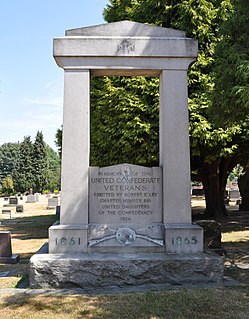Related Research Articles

Georgetown is a town and the county seat of Sussex County, Delaware, United States. According to the 2010 census, the population of the town is 6,422, an increase of 38.3% over the previous decade.

The Sons of Confederate Veterans (SCV) is an American neo-Confederate nonprofit organization of male descendants of Confederate soldiers that commemorates these ancestors, funds and dedicates monuments to them, and promotes the pseudohistorical Lost Cause ideology and corresponding white supremacy.

The South Carolina State House is the building housing the government of the U.S. state of South Carolina, which includes the South Carolina General Assembly and the offices of the Governor and Lieutenant Governor of South Carolina. Located in the capital city of Columbia near the corner of Gervais and Assembly Streets, the building also housed the Supreme Court until 1971.
The 1st Delaware Infantry Regiment, later known as the 1st Delaware Veteran Infantry Regiment was a United States volunteer infantry regiment raised for Union Army service in the American Civil War. Part of the II Corps it served in the Eastern Theater of the American Civil War.

The Confederate Monument in Georgetown is within the Georgetown Cemetery of Georgetown, Kentucky. It is an unpolished granite obelisk that is twenty feet tall, surrounded by the graves of eighteen former Confederate soldiers. The various reliefs upon the obelisk include crossed cannons, crossed muskets, a drum, an azid, and flags. It was placed on the National Register of Historic Places on July 17, 1997 as part of the Civil War Monuments of Kentucky Multiple Property Submission.

The Confederate Monument in Portsmouth, Virginia, was built between 1876 and 1881. It was listed on the National Register of Historic Places (NRHP) in 1997.

Chester Rural Cemetery is a historic rural cemetery founded in March 1863 in Chester, Pennsylvania. Some of the first burials were Civil War soldiers, both Union and Confederate, who died at the government hospital located at the nearby building which became the Crozer Theological Seminary.

Brittany Ann Byuarm "Bree" Newsome Bass is an American filmmaker, musician, speaker, and activist from Charlotte, North Carolina. She is best known for her act of civil disobedience on June 27, 2015, when she was arrested for removing the Confederate flag from the South Carolina state house grounds in the aftermath of the Charleston church shooting. The resulting publicity put pressure on state officials to remove the flag, and it was taken down permanently on July 10, 2015.

Although the Confederate States of America dissolved at the end of the American Civil War (1861–1865), its battle flag continues to receive modern display. The modern display began during the 1948 United States presidential election when it was used by the Dixiecrats, a political party that opposed civil rights for African Americans. Further display of the flag was a response to the civil rights movement and the passage of federal civil rights laws in the 1950s and 1960s.

The Jefferson Davis Monument, also known as the Jefferson Davis Memorial, was an outdoor sculpture and memorial to Jefferson Davis, installed at Jeff Davis Parkway and Canal Street in New Orleans, Louisiana, United States from 1911 to 2017.

The Palmetto Regiment of Volunteers of South Carolina was an infantry regiment that participated in the Mexican–American War. It suffered heavy losses and was known for the first American colors over Mexico City, when it raised its regimental flag.
Since the 1960s, many municipalities in the United States have removed monuments and memorials on public property dedicated to the Confederate States of America, and some, such as Silent Sam in North Carolina, have been torn down by protestors. Efforts to remove Confederate memorials increased in the late 2010s after high-profile incidents including the Charleston church shooting (2015), the Unite the Right rally (2017), and the murder of George Floyd (2020). The removals have been driven by historical analysis that the monuments express and re-enforce white supremacy; memorialize an unrecognized, treasonous government, the Confederacy, whose founding principle was the perpetuation and expansion of slavery; and that the presence of these Confederate memorials over a hundred years after the defeat of the Confederacy continues to disenfranchise and alienate African Americans.

Jefferson Davis Park is a private park located outside Ridgefield, Washington, in the southwestern portion of the state. The granite markers of the unofficial Jefferson Davis Memorial Highway are at the center of the park surrounded by Confederate flags. Operated by the Pacific Northwest chapter of the Sons of Confederate Veterans, the park commemorates Jefferson Davis, the president of the Confederate States of America.

Flaggers are one of the several neo-Confederate groups active in the Southern United States. Flaggers usually operate at the state level. Their primary purpose is to make the Confederate battle flag as visible as possible.

The United Confederate Veterans Memorial was a Confederate monument in Seattle's privately owned Lake View Cemetery, in the U.S. state of Washington. The memorial was erected by the United Daughters of the Confederacy in 1926. It was constructed of quartz monzonite from Stone Mountain, the Georgia landmark.
References
- ↑ "Confederate flag to stay over Delaware museum".
- ↑ Fishman, Margie (2017-08-15). "Delaware leaders make no moves to oust Confederate monument". The News Journal . Retrieved 2017-08-30.
- ↑ Tavernise, Sabrina (2017-08-30). "A Boom in Confederate Monuments, on Private Land". The New York Times. ISSN 0362-4331 . Retrieved 2017-08-30.